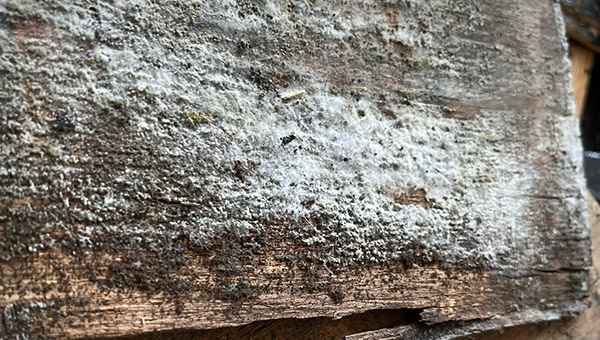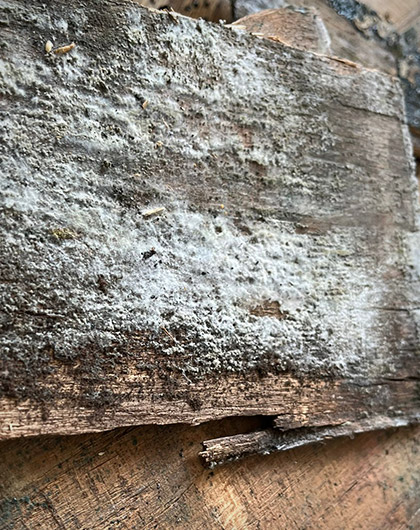
If you've noticed a white, cotton-like substance growing on your drywall, you're likely dealing with a specific type of mold that thrives in damp, poorly ventilated areas. This fuzzy white mold on walls often appears soft, powdery, or fluffy, resembling cotton or wool, and can be a sign of deeper moisture issues within your home.
While it may not look as threatening as black mold, white mold on drywall can still pose health risks and cause structural damage if left untreated. It's commonly caused by high humidity, leaking pipes, or condensation behind walls, and is often associated with mold species like Chaetomium, Mucor, and Penicillium.
Whether you're trying to figure out what that strange white fuzz is, or you're looking for safe and effective ways to deal with it, this article will walk you through the key things to know - from spotting early signs to choosing the right removal methods and preventing future growth.
White mold on drywall often shows up as fluffy patches that resemble cotton balls or soft dust. It may look harmless at first, but this type of mold can spread quickly - especially in areas with excess moisture, poor airflow, or hidden water damage.
These textures are commonly linked to mold species like Mucor and Chaetomium, which thrive in damp, dark environments. Unlike black mold, which often appears slimy or speckled, white mold tends to look soft, dry, and cotton-like, making it easy to overlook until it spreads.
It's also worth noting that efflorescence, a mineral deposit caused by water seepage, can look similar. But unlike mold, efflorescence feels gritty, doesn't have a musty smell, and won't smear when touched.
If you spot something that looks like white fuzz on your drywall, it's best to act quickly. The longer mold is left untreated, the more damage it can cause, not just to your walls, but to your indoor air quality and health.

Mold doesn't just appear out of nowhere, it needs the right conditions to grow. When it comes to cotton-like mold on drywall, the most common culprits are moisture, warmth, and poor airflow. If any of these factors are present in your home, especially over time, mold spores can settle and start to spread.
Here are the most frequent causes:
Rooms with consistently high humidity, like bathrooms, basements, or laundry areas, create the perfect environment for mold to thrive. When the air is too moist, drywall can absorb that moisture, leading to white fuzzy mold growth.
Leaking pipes, roof damage, or even minor plumbing issues can introduce moisture behind walls. This hidden dampness often goes unnoticed until fluffy white mold starts to appear on the surface.
In colder months or poorly insulated homes, condensation can build up behind drywall. Over time, this trapped moisture becomes a breeding ground for mold spores, especially in areas with limited ventilation.
Without proper airflow, moisture lingers in the air and settles on surfaces. Spaces like closets, attics, or corners behind furniture are especially vulnerable to mold growth on drywall due to stagnant air.
If your home has experienced flooding or water intrusion, and the drywall wasn't dried thoroughly, mold can begin to grow within 24-48 hours. Even small spills that seep into walls can lead to white mold if not addressed quickly.
Cotton-like mold is almost always a sign of excess moisture. Whether it's from a slow leak, poor ventilation, or high humidity, identifying and fixing the source of moisture is the first step toward effective mold remediation. The sooner you act, the easier it is to stop mold before it spreads.
While white mold on drywall may not look as alarming as black mold, it can still pose serious health concerns, especially for people with allergies, asthma, or weakened immune systems. The fluffy, cotton-like appearance might seem harmless, but the spores it releases can affect indoor air quality and trigger a range of symptoms.
Yes, it can be. Although not all white molds are toxic, many species,like Penicillium, Mucor, and Chaetomium, can cause health issues when inhaled over time. These molds release microscopic spores into the air, which can irritate the respiratory system and lead to chronic symptoms.
Exposure to white mold on drywall may lead to:
In rare cases, fungal infections (especially in immunocompromised individuals)
Penicillium is a common white mold found on drywall and other building materials. While it's used in antibiotics, airborne Penicillium spores can trigger allergic reactions in sensitive individuals. Symptoms may include sinus pressure, wheezing, or skin rashes.
Not all white mold is toxic, but it's difficult to tell the difference without lab testing. Some species may produce mycotoxins, which can be harmful in high concentrations. That's why it's important to treat any mold growth seriously, regardless of color or texture.
Even if it looks less threatening than black mold, white fuzzy mold on drywall can still impact your health and comfort. If you or your family are experiencing unexplained symptoms and notice mold growth at home, it's time to take action. Safe, thorough removal is key to restoring a healthy indoor environment.
Once you've identified cotton-like mold on your drywall, the next step is taking action. Whether it's a small patch or a larger infestation, removing mold safely and thoroughly is essential to protect your home and health. Here's how to approach it effectively.
If the mold covers a small area (less than 10 square feet), you may be able to handle it yourself using household products. Always wear gloves, a mask, and eye protection.
DIY cleaning options include:
If the mold has penetrated deeply or the drywall feels soft, crumbly, or smells musty even after cleaning, it's best to remove and replace the affected section. Mold can compromise the structural integrity of drywall and continue to grow underneath the surface.
For larger infestations or recurring mold problems, professional mold remediation is the safest and most effective option. Our experts use specialized equipment to:
While costs vary, professional mold removal ensures the job is done thoroughly and helps prevent future outbreaks.
Whether you're tackling a small patch of white fuzzy mold or dealing with widespread growth, the key is to act quickly and thoroughly. DIY methods can work for minor issues, but don't hesitate to call in professionals if the mold is extensive or keeps coming back. The longer mold sits, the more damage it can do - not just to your drywall, but to your indoor air quality and peace of mind.
When it comes to tackling cotton-like mold on drywall, having the right tools and products can make the job faster, safer, and more effective. Whether you're handling a small DIY cleanup or preparing for professional remediation, here are some essentials to consider.

Look for EPA-registered mold removers that are safe for indoor use and effective on porous surfaces like drywall. Some top-rated options include:
After cleaning or replacing drywall, applying a mold-resistant primer or paint can help prevent future growth. These products contain fungicides that inhibit mold development on painted surfaces.
Look for:
Since moisture is the root cause of most mold problems, controlling humidity is key. Consider investing in:
If you're handling mold yourself, don't forget safety gear:
Having the right products and tools on hand can make mold removal more effective and help prevent it from coming back. From mold removers and resistant paints to dehumidifiers and safety gear, these essentials support a cleaner, healthier home environment.
White mold on drywall may look soft and harmless, but it's often a sign of deeper moisture problems that can affect your home's structure and your health. From its fluffy white appearance to the musty smell it brings, this type of mold thrives in damp, poorly ventilated spaces, and it won't go away on its own.
The good news? With the right knowledge, tools, and action plan, mold can be removed safely and prevented from coming back. Whether you're tackling a small patch with DIY methods or need full-scale remediation, addressing the issue early is key to avoiding costly repairs and long-term exposure.
If you're dealing with persistent mold or unsure where to start, FDP Mold Remediation is here to help. Our team specializes in safe, effective mold removal tailored to your home's needs - so you can breathe easier and live healthier.



